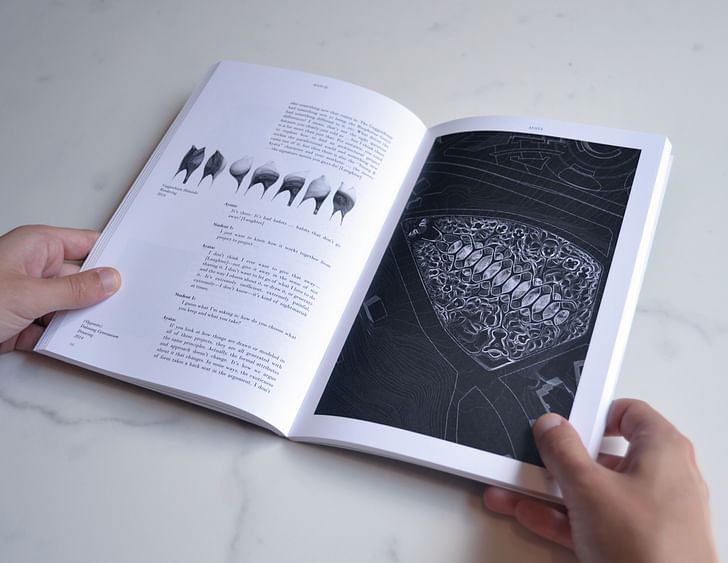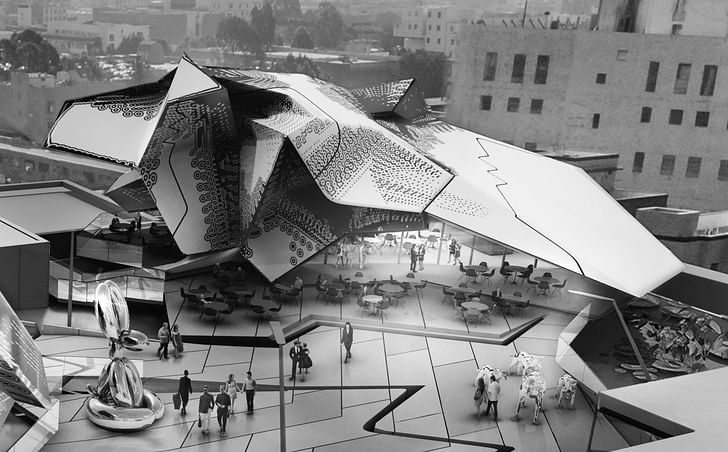

What is architectural discourse in an era of so-called "quick images"? As a collection of conversations between students and professors, Hatch explores the culture of social media and the subsequent disconnect it has created between disciplined, professional works of architecture and flashy (if ubiquitous) presentations.
The notion of "disruption" has provided endless amounts of glee to those who bored with the slow, seemingly stodgy processes of numerous industries—such as publishing and media presentation for instance. But the disruption of considered, thoughtful processes isn't necessarily a great thing for architecture. As the students at the University of Pennsylvania School of Design state in their description of Hatch: On The State of Quick Images, "the discipline, as we see it, ismass media has begun a campaign to make architecture provincial. currently defined by a vast plurality of projects and a new age of viewing (and judging) work via online blogs and social media sites. These sites highlight visual content and quick images, typically with little concern for curation or cohesion. For us, the quick image blurs categories and disciplinary positions to mere images of form, shape, color, style, and trends." These students certainly aren't Luddites, but they're still trying to understand exactly where architectural discourse is situated in the era of the "quick image".
In the following excerpt, lecturer and architect Tom Wiscombe investigates with a Penn student the claim that "mass media has begun a campaign to make architecture provincial."

I was at your midterm and after the first presentation, all the jurors kind of attacked you on a couple issues …
Is that what that looked like? [Laughter]
Something that I could make out of it was the idea about de-contextualizing the project. Can you just summarize what was happening there and how would you defend yourself on it?

So, this is a three part question in my brain. The first part is: what’s the point of having a review in architecture? It wasn’t always the case that we did public juries … don’t forget that. Alvin Boyarsky from the AA invented juries in their contemporary form. That was not that long ago. Before that it was closer to a You are forced to mount a defense in real-time. Beaux-Arts model of mentor to student, which could potentially become sentimental or destructive, and certainly did nothing to foster architectural discourse. Anyway, what went down at the midterm was me inviting people who I consider to be smarter than me to the review, which I like to do at that point in a semester, in order to test the agenda, the assumptions, and maybe even the techniques if the jury is good. You are forced to mount a defense in real-time. Ultimately, you agree with them and change it up, or more likely you press forward and try to integrate things you heard. That’s what I always try to do anyway. The point of a midterm review is for both the students and the teachers to learn.

So, what you heard were my smart friends basically saying, “But seriously, are you talking about a new project of autonomy? And, if so, in what terms and how do you deal with context which is there, like it or not?” So, what I was fighting for in the review, and what we’re all fighting for in the studio right now, is the idea that over the last ten years, mass media has begun a campaign to make architecture provincial. We always hear about context, as if architecture could be drawn forth from it. reviews are there to produce and reveal contention about architectural ideas.I will tell you, it cannot. So in studio we are turning the volume up to eleven to see how we could be contextual but in a radically different way, by being so self-reflexive that the building literally creates a new world and then begins to influence and remake its context. That is why we are using the “light studio” I mentioned earlier—the light studio is of this earth but also not of this earth. It is real but it has no determinate scale. The effects it produces might range from something like a toy to something like a black hole. This interest is related to Timothy Morton’s hyperobjects, or rethinking the world in terms of things which are massively distributed and disassociated with anthropocentric notions of scale.

So to try to answer the third part of your question, ultimately I believe that reviews are there to produce and reveal contention about architectural ideas. Otherwise, if everyone agrees, then what’s the point of bringing people together? I believe that the review is as much for the instructors as for the students. Ideas like non-local context, vicarious context, or fictional context are not fully formed, and it’s productive to swarm on them, or maybe even kill them.
This semester I’d say we’re embarking on an extreme route, which I’m calling at this point, “None More Black.” [Laughter] That comes from Spinal Tap. Can we show that clip?
(Break to watch “None More Black” scene from "This is Spinal Tap")
So, we’ve been asking that question in studio. How can it be more black, and at this point it can’t be, it can be only none … none more black. [Laughter] But seriously, we are finding so many blacks, matte to gloss, and even chrome, which is really even more black than black … Notice I am talking about materiality, and not materials, which is related to the idea of tectonic fictions.

Hatch: On the State of Quick Images also includes conversations with Penn faculty members Kutan Ayata, Josh Freese, Ferda Kolatan, Michael Loverich, Eduardo Rega, and Andrew Saunders, with a foreword by Nate Hume. It can be purchased here.
Screen/Print is an experiment in translation across media, featuring a close-up digital look at printed architectural writing. Divorcing content from the physical page, the series lends a new perspective to nuanced architectural thought.
For this issue, we featured Hatch: On the State of Quick Images from the University of Pennsylvania School of Design.
Do you run an architectural publication? If you’d like to submit a piece of writing to Screen/Print, please send us a message.
Julia Ingalls is primarily an essayist. Her work has appeared or is forthcoming in Slate, Salon, Dwell, Guernica, The LA Weekly, The Nervous Breakdown, Forth, Trop, and 89.9 KCRW. She's into it.
No Comments
Block this user
Are you sure you want to block this user and hide all related comments throughout the site?
Archinect
This is your first comment on Archinect. Your comment will be visible once approved.